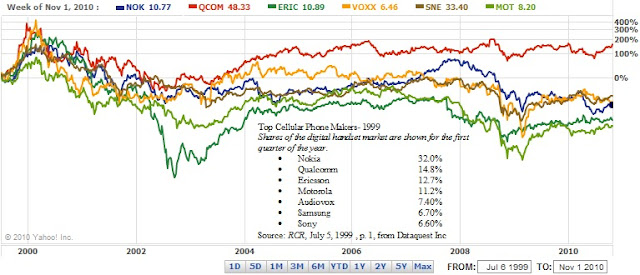Many companies strive to obtain dominance in market share. Market share is thought to be the critical element that will propel a company's stock price higher and dominance in an industry. Unfortunately, that usually isn't the case. As time moves on, a new company takes a commanding role in a market that they were never thought to be a part of. Companies that are market leaders today are likely to become failed behemoths in a few years from now. This is especially true in the technology industry where each new invention is meant to replace all prior technologies by combining all aspects of the old technologies into the new iteration (all things to all people).
In the example below, we show the chart and table of the leaders of the top cellular phone makers in 1999. While we understand that the industry was in its infancy, it is interesting to see the performance of the respective companies in comparison to their leadership roles in the industry. In the nearly 11 years since being on the list, none of the original companies have managed to increase their share price beyond their year 2000 highs. Only one company, Qualcomm (QCOM), has managed to increase its share price above the 1999 level.
Below we show the current mobile phone leaders with Nokia (NOK) still in the number one position while Samsung has gone from number 6th ranked in 1999 to number 2 ranked behind Nokia in 2010.
| Top Five Mobile Phone Vendors, Shipments, and Market Share, Q3 2010 |
| Vendor |
3Q10 Unit Shipments |
3Q10 Market Share |
3Q10/3Q09 Change |
| 1. Nokia |
110.4
|
32.40%
|
1.80%
|
| 2. Samsung |
71.4
|
21.00%
|
18.60%
|
| 3. LG Electronics |
28.4
|
8.30%
|
-10.10%
|
|
4. Apple
|
14.1
|
4.10%
|
90.50%
|
| 5. R.I.M. |
12.4
|
3.60%
|
45.90%
|
| Others |
103.8
|
30.50%
|
28.30%
|
| Total |
340.5
|
100.00%
|
14.60%
|
| Source: IDC Worldwide Quarterly Mobile Phone Tracker, October 28, 2010 |
New entrants like LG, Apple (AAPL) and RIM (RIMM) are now vying for whatever portion of market share that they can. However, the focus on market share may not be so good in either the short and long run for their stock prices as represented in the chart above. With this in mind, those investment analysts who make the case that increased market share is justification for why a stock price should be increased or at a premium should review the same claims of similar companies in periods past.
- Updated mobile data for 1999, 2010, and 2016 available here.

